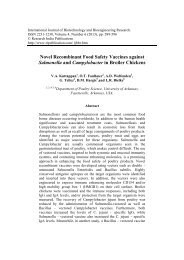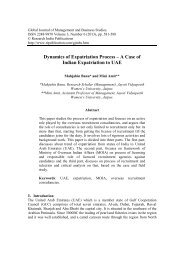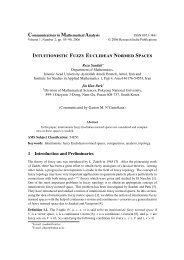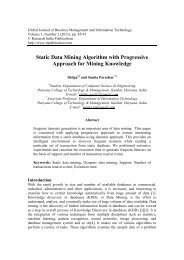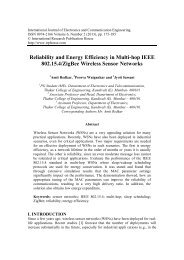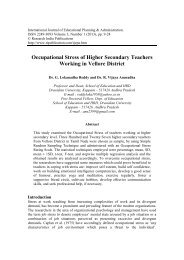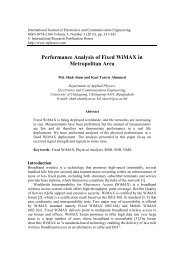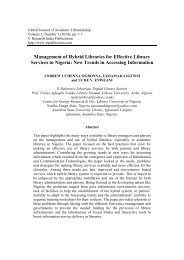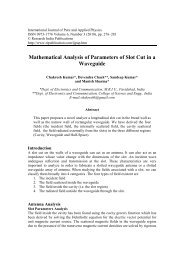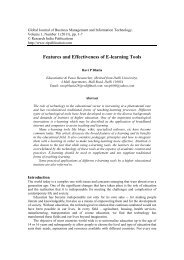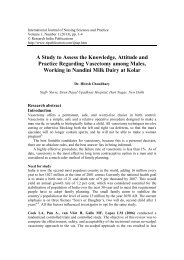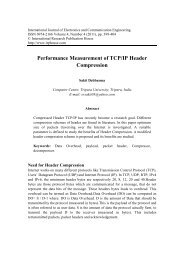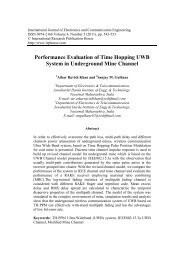Double Talk Detection in Acoustic Echo Cancellation based on ...
Double Talk Detection in Acoustic Echo Cancellation based on ...
Double Talk Detection in Acoustic Echo Cancellation based on ...
You also want an ePaper? Increase the reach of your titles
YUMPU automatically turns print PDFs into web optimized ePapers that Google loves.
Internati<strong>on</strong>al Journal of Electr<strong>on</strong>ics and Communicati<strong>on</strong> Eng<str<strong>on</strong>g>in</str<strong>on</strong>g>eer<str<strong>on</strong>g>in</str<strong>on</strong>g>g.ISSN 0974-2166 Volume 4, Number 5 (2011), pp. 537-542© Internati<strong>on</strong>al Research Publicati<strong>on</strong> Househttp://www.irphouse.com<str<strong>on</strong>g>Double</str<strong>on</strong>g> <str<strong>on</strong>g>Talk</str<strong>on</strong>g> <str<strong>on</strong>g>Detecti<strong>on</strong></str<strong>on</strong>g> <str<strong>on</strong>g>in</str<strong>on</strong>g> <str<strong>on</strong>g>Acoustic</str<strong>on</strong>g> <str<strong>on</strong>g>Echo</str<strong>on</strong>g> <str<strong>on</strong>g>Cancellati<strong>on</strong></str<strong>on</strong>g><str<strong>on</strong>g>based</str<strong>on</strong>g> <strong>on</strong> Variance Impulse Resp<strong>on</strong>seS<strong>on</strong>ika and Sanjeev DhullGJUS & T, Hisar, Haryana, IndiaEmail: s<strong>on</strong>ika.kadian@gmail.comAbstractIn this paper we represent a new echo canceller us<str<strong>on</strong>g>in</str<strong>on</strong>g>g double talk detector thatdepends <strong>on</strong> variance impulse resp<strong>on</strong>se. In this method detecti<strong>on</strong> is performedby calculat<str<strong>on</strong>g>in</str<strong>on</strong>g>g the variance of maximum value tap of recent tap <str<strong>on</strong>g>in</str<strong>on</strong>g> adaptivefilter. Adaptive filter will stop updat<str<strong>on</strong>g>in</str<strong>on</strong>g>g its coefficients dur<str<strong>on</strong>g>in</str<strong>on</strong>g>g double talk andit will resume updat<str<strong>on</strong>g>in</str<strong>on</strong>g>g after double talk. Simulati<strong>on</strong> results by us<str<strong>on</strong>g>in</str<strong>on</strong>g>g realspeech signals show the excellence of VIRE double talk detector.Keywords: <str<strong>on</strong>g>Double</str<strong>on</strong>g> talk detector, echo canceller, adaptive filter.Introducti<strong>on</strong>Nowadays, hands free c<strong>on</strong>versati<strong>on</strong> is popular <str<strong>on</strong>g>in</str<strong>on</strong>g> various fields of communicati<strong>on</strong>such as speaker ph<strong>on</strong>e system and telec<strong>on</strong>ference systems. In acoustic echo canceller,however, the performance significantly degrades as double talk occurs i.e. near endand far end talkers coexist. <str<strong>on</strong>g>Echo</str<strong>on</strong>g>es <str<strong>on</strong>g>in</str<strong>on</strong>g> acoustic echo path degrade the communicati<strong>on</strong>quality. Therefore c<strong>on</strong>trol of echoes is very important <str<strong>on</strong>g>in</str<strong>on</strong>g> communicati<strong>on</strong>. In this casethe adaptive filter will stop updat<str<strong>on</strong>g>in</str<strong>on</strong>g>g its coefficients. <str<strong>on</strong>g>Double</str<strong>on</strong>g> talk deteriorates ma<str<strong>on</strong>g>in</str<strong>on</strong>g>lythe speech quality. In Fig. 1 we are hav<str<strong>on</strong>g>in</str<strong>on</strong>g>g an acoustic echo canceller. The pr<str<strong>on</strong>g>in</str<strong>on</strong>g>cipleof acoustic echo canceller is to estimate the impulse resp<strong>on</strong>se of an acoustic echo pathby us<str<strong>on</strong>g>in</str<strong>on</strong>g>g an adaptive filter by generat<str<strong>on</strong>g>in</str<strong>on</strong>g>g a pseudo echo, and subtract it from theecho[1][2].In this Fig. 1y(n) = g(n)+ r(n) + j(n)e(n) = y(n) – ĝ(n)e(n) = error signal, ĝ(n) = estimated echo signal by adaptive filter, r(n) = near endspeechj(t) = background noise.
538 S<strong>on</strong>ika and Sanjeev DhullFigure 1: Simple acoustic echo canceller.Basic pr<str<strong>on</strong>g>in</str<strong>on</strong>g>ciple work<str<strong>on</strong>g>in</str<strong>on</strong>g>g of AEC• A far end signal is delivered to the system.• The far end signal is reproduced by the speaker <str<strong>on</strong>g>in</str<strong>on</strong>g> the room.• A microph<strong>on</strong>e also <str<strong>on</strong>g>in</str<strong>on</strong>g> room picks up the result<str<strong>on</strong>g>in</str<strong>on</strong>g>g direct path sound andc<strong>on</strong>sequent reverberant sound i.e..echo as a near end signal.• The far end signal is subtracted from the pseudo far end replica produced byadaptive filter.• The result<str<strong>on</strong>g>in</str<strong>on</strong>g>g signal represent sounds present <str<strong>on</strong>g>in</str<strong>on</strong>g> room exclud<str<strong>on</strong>g>in</str<strong>on</strong>g>g any direct orany reverberated sound produced by speaker i.e. known as error signal.Dur<str<strong>on</strong>g>in</str<strong>on</strong>g>g double talk situati<strong>on</strong>s, path estimati<strong>on</strong> of echo may be wr<strong>on</strong>g as near endsignal acts as <str<strong>on</strong>g>in</str<strong>on</strong>g>terference to adaptive filter be<str<strong>on</strong>g>in</str<strong>on</strong>g>g used <str<strong>on</strong>g>in</str<strong>on</strong>g> AEC [3]. Therefore doubletalk detectors are needed <str<strong>on</strong>g>in</str<strong>on</strong>g> order to c<strong>on</strong>verge adaptive filters properly.In this paper we proposed a double talk detector i.e. <str<strong>on</strong>g>based</str<strong>on</strong>g> <strong>on</strong> variance impulseresp<strong>on</strong>se. Algorithm we are us<str<strong>on</strong>g>in</str<strong>on</strong>g>g for our cod<str<strong>on</strong>g>in</str<strong>on</strong>g>g is LMS (Least Mean Square).The Proposed <str<strong>on</strong>g>Double</str<strong>on</strong>g> <str<strong>on</strong>g>Talk</str<strong>on</strong>g> DetectorProposed DT detecti<strong>on</strong> algorithm uses the variance impulse resp<strong>on</strong>se to solve theproblem of double talk.The Generic <str<strong>on</strong>g>Double</str<strong>on</strong>g>talk <str<strong>on</strong>g>Detecti<strong>on</strong></str<strong>on</strong>g> Schemes:Almost all types of doubletalk detectors operate <str<strong>on</strong>g>in</str<strong>on</strong>g> the same manner. Therefore, thegeneral procedure for handl<str<strong>on</strong>g>in</str<strong>on</strong>g>g double talk is described by the follow<str<strong>on</strong>g>in</str<strong>on</strong>g>g four steps.
<str<strong>on</strong>g>Double</str<strong>on</strong>g> <str<strong>on</strong>g>Talk</str<strong>on</strong>g> <str<strong>on</strong>g>Detecti<strong>on</strong></str<strong>on</strong>g> <str<strong>on</strong>g>in</str<strong>on</strong>g> <str<strong>on</strong>g>Acoustic</str<strong>on</strong>g> <str<strong>on</strong>g>Echo</str<strong>on</strong>g> <str<strong>on</strong>g>Cancellati<strong>on</strong></str<strong>on</strong>g> 539• A VIRE variance , is formed us<str<strong>on</strong>g>in</str<strong>on</strong>g>g available signals such as x, g and e and theestimated filter coefficients, ĥ.• The VIRE variance, , is compared to a preset threshold, T, (a c<strong>on</strong>stant), anddouble talk is declared if T.• Once doubletalk is declared the detecti<strong>on</strong> is held for a m<str<strong>on</strong>g>in</str<strong>on</strong>g>imum period of timeT hold. While the detecti<strong>on</strong> is held the filter adaptati<strong>on</strong> is disabled.• If T c<strong>on</strong>secutively over a time T hold the filter resumes adaptati<strong>on</strong> whilethe comparis<strong>on</strong> of to T c<strong>on</strong>t<str<strong>on</strong>g>in</str<strong>on</strong>g>ues until β > T aga<str<strong>on</strong>g>in</str<strong>on</strong>g>.The hold time, T hold, <str<strong>on</strong>g>in</str<strong>on</strong>g> steps 3 and 4 is essential to suppress detecti<strong>on</strong> dropoutsdue to the noisy behavior of the detecti<strong>on</strong> statistic [4]. Although there are somepossible variati<strong>on</strong>s most of the DTD algorithms keep this basic form and <strong>on</strong>ly differ <str<strong>on</strong>g>in</str<strong>on</strong>g>how they form the VIRE variance. A n<strong>on</strong>l<str<strong>on</strong>g>in</str<strong>on</strong>g>ear processor, (NLP), is a signalprocess<str<strong>on</strong>g>in</str<strong>on</strong>g>g circuit or algorithm that is placed <str<strong>on</strong>g>in</str<strong>on</strong>g> the speech path after echo cancellati<strong>on</strong><str<strong>on</strong>g>in</str<strong>on</strong>g> order to provide further attenuati<strong>on</strong> or removal of residual echo signals that cannotbe removed completely by an echo canceller. A n<strong>on</strong>-l<str<strong>on</strong>g>in</str<strong>on</strong>g>earity, a distorti<strong>on</strong>, or anadded noise signal is examples of signals that cannot be fully cancelled by an echocanceller. Therefore, these signals are typically removed or attenuated by a n<strong>on</strong>l<str<strong>on</strong>g>in</str<strong>on</strong>g>earprocessor. A comfort noise generator (CNG) is used to generate background noise forvoice communicati<strong>on</strong>s dur<str<strong>on</strong>g>in</str<strong>on</strong>g>g periods of silence that occur dur<str<strong>on</strong>g>in</str<strong>on</strong>g>g the course ofc<strong>on</strong>versati<strong>on</strong>.Figure 2: <str<strong>on</strong>g>Echo</str<strong>on</strong>g> Canceller us<str<strong>on</strong>g>in</str<strong>on</strong>g>g DTD.
540 S<strong>on</strong>ika and Sanjeev DhullThe follow<str<strong>on</strong>g>in</str<strong>on</strong>g>g notati<strong>on</strong>s are used:ĉ(t) = adaptive color<str<strong>on</strong>g>in</str<strong>on</strong>g>g filter /comfort noise, NLP = n<strong>on</strong> l<str<strong>on</strong>g>in</str<strong>on</strong>g>ear processor, e(t) =error signalg(t) = estimated echoic signal, ĝ (t) = replica of estimated signal, r(t) = near endtalk, j(t) = background noiseHeree(t) = d(t) – ŷ(t)= d(t) + s(t) + n(t) – ŷ(t)In this system CNG (comfort noise generator) and NLP (n<strong>on</strong> l<str<strong>on</strong>g>in</str<strong>on</strong>g>ear processor) areused <str<strong>on</strong>g>in</str<strong>on</strong>g> order to improve the further output.There are ma<str<strong>on</strong>g>in</str<strong>on</strong>g>ly two methods for sort<str<strong>on</strong>g>in</str<strong>on</strong>g>g out the problem of dtd:Geigel methodThis method is hav<str<strong>on</strong>g>in</str<strong>on</strong>g>g very simple Geigel algorithm with low complexity. It is <str<strong>on</strong>g>based</str<strong>on</strong>g><strong>on</strong> the assumpti<strong>on</strong> that, when we receive the signal, far end talk has lower power thanthat of the near end. <str<strong>on</strong>g>Talk</str<strong>on</strong>g> detecti<strong>on</strong> can be d<strong>on</strong>e with threshold basis [5].VIRE methodIn this paper we are deal<str<strong>on</strong>g>in</str<strong>on</strong>g>g with variance impulse resp<strong>on</strong>se algorithm. VarianceImpulse Resp<strong>on</strong>se algorithm calculates the variance of maximum value of the recenttaps <str<strong>on</strong>g>in</str<strong>on</strong>g> adaptive filters. If the variance exceeds some threshold, which could be variedover time, we have double talk. In other words, if estimated room impulse resp<strong>on</strong>sechanges a lot, we assume that it is not the room has changed, but some other sourcesof sound has occurred[6].We have evaluated out the performance of our proposed double talk detecti<strong>on</strong>algorithm through computer simulati<strong>on</strong>. We have used the least mean squarealgorithm for the adaptive filter and acts step size parameter is set to 1. Adaptive filterlength is taken to be 1000, double talk memory assumed to be 1000 and forgett<str<strong>on</strong>g>in</str<strong>on</strong>g>gfactor is equals to.97 but it can be changed and also the white Gaussian noise strengthis statically assigned to be -27.In Fig. 3 we have shown different signals, Fig. 4 shows the Vire Variance, Fig. 5& 6 shows the comparis<strong>on</strong> of ERLEs.Now ERLE (<str<strong>on</strong>g>Echo</str<strong>on</strong>g> return loss enhancement) can be formulated as:ERLE = -10 Here is power of the microph<strong>on</strong>e signal and is the power of residualecho.
<str<strong>on</strong>g>Double</str<strong>on</strong>g> <str<strong>on</strong>g>Talk</str<strong>on</strong>g> <str<strong>on</strong>g>Detecti<strong>on</strong></str<strong>on</strong>g> <str<strong>on</strong>g>in</str<strong>on</strong>g> <str<strong>on</strong>g>Acoustic</str<strong>on</strong>g> <str<strong>on</strong>g>Echo</str<strong>on</strong>g> <str<strong>on</strong>g>Cancellati<strong>on</strong></str<strong>on</strong>g> 541Figure 3: Waveform from top to bottom far end signal, near end signal, microph<strong>on</strong>epickup signal, filtered signal and double talk detecti<strong>on</strong>.Figure 4: The VIRE VarianceFigure 5: ERLE of AEC without us<str<strong>on</strong>g>in</str<strong>on</strong>g>g DTD.
542 S<strong>on</strong>ika and Sanjeev DhullFigure 6: ERLE of AEC with DTD.C<strong>on</strong>clusi<strong>on</strong>In this paper, we propose a double talk detecti<strong>on</strong> us<str<strong>on</strong>g>in</str<strong>on</strong>g>g the VIRE DTD <str<strong>on</strong>g>in</str<strong>on</strong>g> <str<strong>on</strong>g>Acoustic</str<strong>on</strong>g><str<strong>on</strong>g>Echo</str<strong>on</strong>g> Canceller. The experimental results have shown the robustness of proposedDTD as well as the performance improvement of acoustic echo canceller.References[1] Hirotsugu Urakami and Yosh<str<strong>on</strong>g>in</str<strong>on</strong>g>obu Kajikawa, 2010, “A <str<strong>on</strong>g>Double</str<strong>on</strong>g>-<str<strong>on</strong>g>Talk</str<strong>on</strong>g>-DetectorUs<str<strong>on</strong>g>in</str<strong>on</strong>g>g Sound and Image Informati<strong>on</strong>” IEEE Proceed<str<strong>on</strong>g>in</str<strong>on</strong>g>g.[2] Jae Ha Yoo*, Soo Chan Kim, 2010, “A new echo canceller us<str<strong>on</strong>g>in</str<strong>on</strong>g>g double talkdetector <str<strong>on</strong>g>based</str<strong>on</strong>g> <strong>on</strong> the accumulated number of selecti<strong>on</strong> of the scale factor”ICSP Proceed<str<strong>on</strong>g>in</str<strong>on</strong>g>g.[3] Artur Ferreira Paulo Marques, 2008, “An Efficient L<strong>on</strong>g Distance <str<strong>on</strong>g>Echo</str<strong>on</strong>g>Canceller” ICSES.[4] W<strong>on</strong>chul Heo, Taehwan Kim, and Keunsung Bae, 2007, “Robust <str<strong>on</strong>g>Double</str<strong>on</strong>g>-talk<str<strong>on</strong>g>Detecti<strong>on</strong></str<strong>on</strong>g> <str<strong>on</strong>g>in</str<strong>on</strong>g> the <str<strong>on</strong>g>Acoustic</str<strong>on</strong>g> <str<strong>on</strong>g>Echo</str<strong>on</strong>g> Canceller us<str<strong>on</strong>g>in</str<strong>on</strong>g>g Normalized Error SignalPower” IEEE.[5] H. Haghshenas and M. MalmirCheg<str<strong>on</strong>g>in</str<strong>on</strong>g>i, Member, IEEE, 2007 “A Novel<str<strong>on</strong>g>Double</str<strong>on</strong>g>-<str<strong>on</strong>g>Talk</str<strong>on</strong>g> Detector Based <strong>on</strong> Adaptive Estimati<strong>on</strong> of Near-End Power”IEEE Proc.[6] Mohammad Asif Iqbal and Steven L. Grant, 2007, “A Novel NormalizedCross-Correlati<strong>on</strong> Based <str<strong>on</strong>g>Echo</str<strong>on</strong>g>-Path Change Detector” IEEE Proc.



